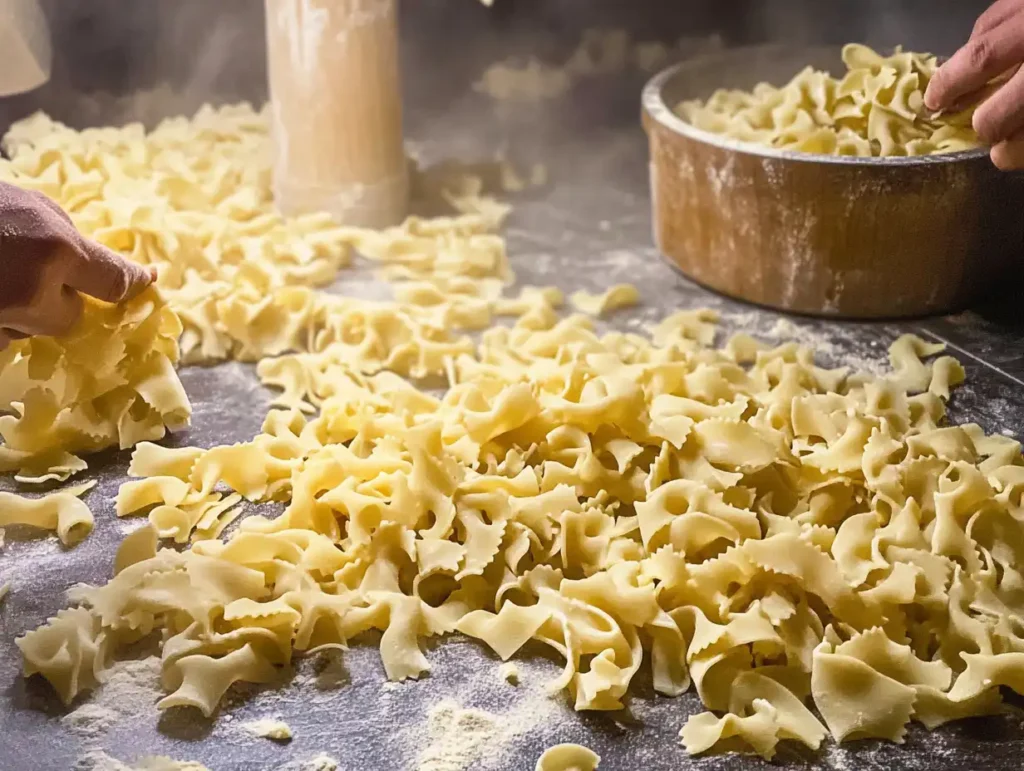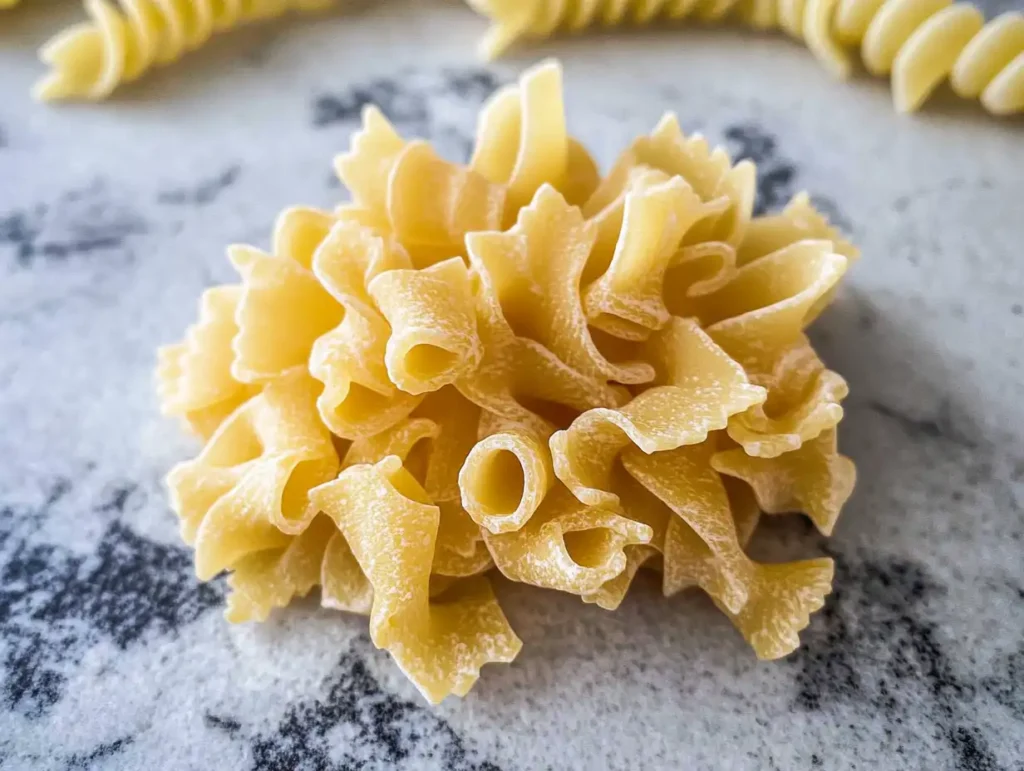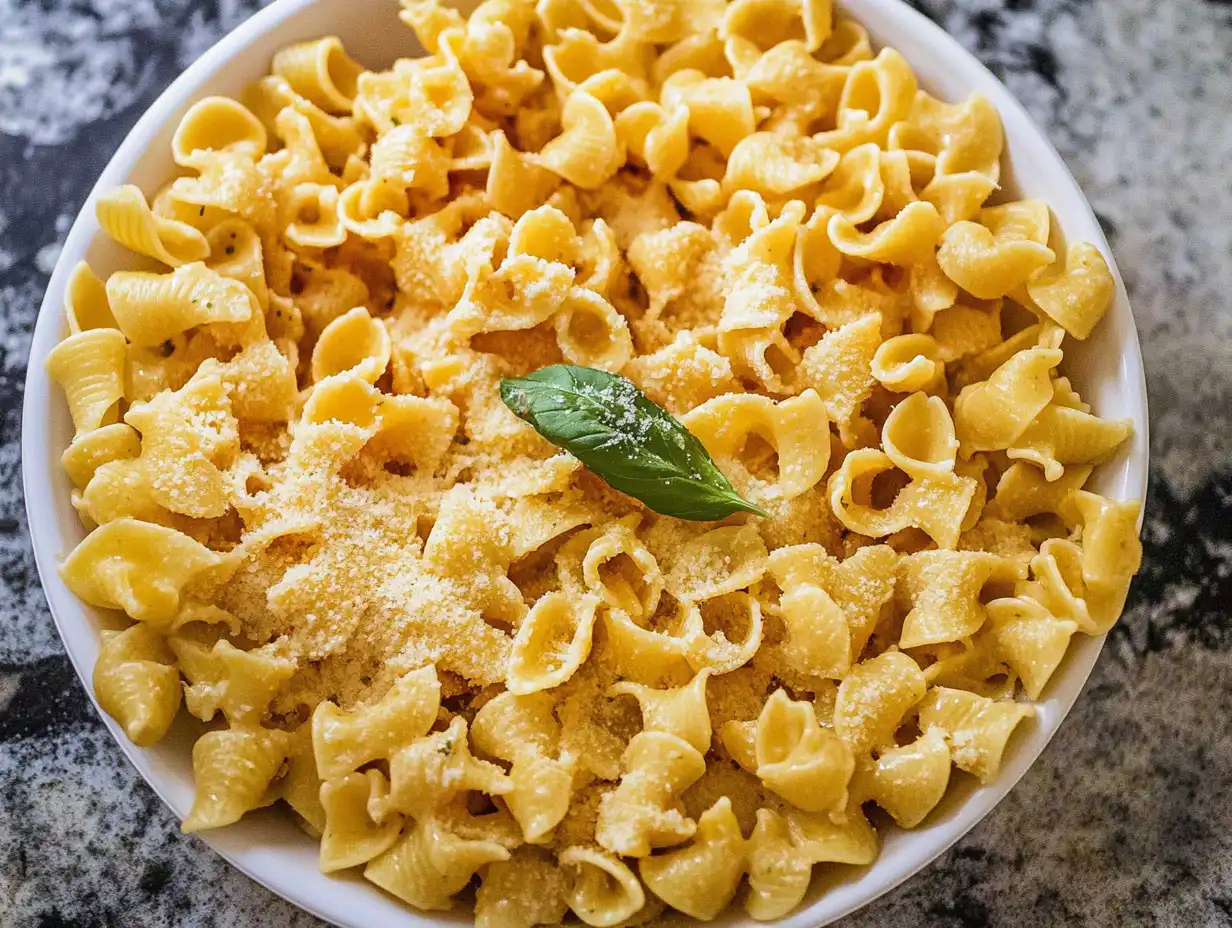Introduction
Pasta holds a cherished place in Italian cuisine, and among its many forms, Gigli pasta stands out for its elegance and symbolism. With its unique flower-like shape, Gigli pasta, also called “Campanelle,” evokes the iconic lily that has been a symbol of Florence for centuries. But where is Gigli pasta from, and what makes it special? Let’s explore the origins, history, and culinary significance of this delightful pasta.
History of Gigli Pasta
Early History of Pasta in Italy
Italy’s love affair with pasta stretches back centuries, with its roots intertwined in the country’s cultural and culinary identity. Pasta began as a simple food made from flour and water, with early examples traced back to Etruscan civilizations and Roman times. Over centuries, regional differences flourished, resulting in the development of diverse pasta shapes and styles.

Gigli pasta, like many other types, is a product of this innovation and creativity. Its origins are closely linked to Florence, a city celebrated for its art, history, and unique contributions to Italian gastronomy.
Evolution of Pasta Types
The diversity of pasta in Italy owes much to the local environments, available ingredients, and culinary traditions. Shapes like spaghetti and penne became staples, while more elaborate forms, such as Gigli, reflected the artistry of Italian pasta-making. Gigli’s shape, resembling a bell or a flower with ruffled edges, symbolizes Florence’s deep cultural connection with beauty and symbolism.
Introduction of Gigli Pasta
Gigli pasta likely emerged in the Renaissance period, when Florence was at its cultural zenith. The shape was inspired by the “giglio,” the Italian word for lily, a flower deeply associated with Florence. It became both a culinary and artistic expression, showcasing the city’s attention to detail and passion for aesthetics.
Gigli Pasta and Florence
Connection Between Gigli Pasta and Florence
Gigli pasta is more than just a type of food; it is a celebration of Florence’s rich heritage. The word “Gigli” translates to “lily” in Italian, and the pasta’s distinctive fluted shape mirrors the lily flower. The lily has been the symbol of Florence since the 11th century, often appearing on the city’s coat of arms, architecture, and artwork. This connection imbues Gigli pasta with cultural significance, making it a culinary tribute to one of Italy’s most iconic cities.
The Symbolism of the Lily in Florence
The lily holds a prominent place in Florentine history and art. It symbolizes purity, renewal, and the city’s resilience. During the Renaissance, Florence’s leaders and artists embraced the lily as a representation of their city’s beauty and strength. Gigli pasta, with its intricate flower-like shape, mirrors this cultural identity, transforming a simple food item into a meaningful artistic expression.
Regional Celebrations Featuring Gigli Pasta
In Florence, culinary traditions often intersect with festivals and local celebrations. Gigli pasta frequently appears during events like the Festa di San Giovanni (Feast of Saint John), the city’s patron saint. Its symbolic shape makes it a favored choice for honoring Florence’s heritage, blending tradition and gastronomy in unique ways.
Why Gigli Pasta is a Florence Specialty
While pasta varieties are common across Italy, the design of Gigli pasta specifically reflects the Florentine aesthetic. Its delicate, ruffled edges and unique appearance require meticulous craftsmanship, a hallmark of Florentine artistry. The association with the city’s symbol makes Gigli pasta a proud emblem of regional pride.
Characteristics of Gigli Pasta

Unique Shape and Design
Gigli pasta, also known as Campanelle (Italian for “little bell”), is instantly recognizable for its beautiful, flower-like structure. The pasta is shaped like a cone with fluted, petal-like edges, resembling a blooming lily or a bellflower. This design is not only aesthetically pleasing but also functional, as it excels at holding sauces, making each bite flavorful and satisfying.
Texture and Versatility
Made from durum wheat semolina, Gigli pasta has a firm and chewy texture when cooked al dente. Its structure is sturdy enough to pair with a variety of sauces, from thick ragùs to lighter cream-based or vegetable sauces. This versatility makes it a favorite choice for both traditional and contemporary recipes.
Differentiating Gigli from Other Pastas
Unlike simple shapes such as penne or spaghetti, Gigli pasta stands out for its ornate appearance. The ruffled edges create additional surface area, allowing the pasta to absorb and cling to sauces better than smoother shapes. This feature, combined with its symbolic design, makes Gigli pasta a distinctive addition to any dish.
Cultural Significance of the Shape
The lily-like form of Gigli pasta ties it to Florence, as it mirrors the city’s emblematic flower. Beyond its culinary appeal, this shape represents the artistry and heritage of the region, making it a conversation starter at dining tables around the world.
How Gigli Pasta is Made
Traditional Ingredients
The foundation of Gigli pasta lies in its simplicity, using only a few high-quality ingredients. Traditional recipes rely on:
- Durum Wheat Semolina: This hard wheat variety is prized for its high gluten content, which gives the pasta its firm structure and distinctive chewy texture.
- Water: Pure, clean water binds the flour to create a dough that is elastic yet sturdy.
Some artisanal producers may incorporate eggs for added richness, particularly in fresh Gigli pasta varieties, though dried versions typically stick to the classic formula.
Traditional Craftsmanship
Making Gigli pasta by hand is a time-honored process that highlights Italian culinary artistry. Artisans begin by kneading the semolina and water mixture into a smooth, pliable dough. Once rested, the dough is rolled out and shaped into small cones with fluted edges, mimicking the petals of a lily. This meticulous shaping is done either by hand or with specialized molds, ensuring each piece retains its characteristic flower-like appearance.
Modern Manufacturing Techniques
While handmade Gigli pasta is still cherished, modern technology has made it easier to produce on a larger scale. Industrial pasta makers use extrusion machines to form Gigli’s intricate shape, pressing the dough through custom-designed dies. These machines ensure uniformity in size and structure while maintaining the integrity of the traditional design.
Drying and Packaging
After shaping, Gigli pasta is dried to preserve its shelf life and maintain its texture. The drying process can vary depending on the producer, with artisanal makers often opting for slow, low-temperature drying to retain the pasta’s natural flavor and nutrients. Once dried, the pasta is carefully packaged, ready to be shipped to homes and restaurants worldwide.
Regional Adaptations in Ingredients
In certain regions of Italy, local flours or alternative grains, such as spelt or whole wheat, may be used to create variations of Gigli pasta. These adaptations reflect the diverse culinary traditions of Italy while keeping the essence of the pasta intact.
Regional Variations of Gigli Pasta
Variations Across Italy
Although Gigli pasta is deeply tied to Florence, variations in its preparation and presentation can be found across Italy. Each region lends its unique touch to this iconic pasta, incorporating local ingredients and traditions to create distinct interpretations:
- Tuscany (Florence): The classic Gigli pasta stays true to its origins, often paired with hearty sauces like wild boar ragù or Chianti-based reductions, reflecting the region’s robust flavors.
- Emilia-Romagna: This region, known for its creamy sauces, might feature Gigli pasta with a rich Parmesan and cream-based sauce, highlighting its ability to cling to smooth textures.
- Southern Italy: In regions like Calabria or Sicily, Gigli pasta may be paired with spicy tomato sauces infused with chili peppers, capers, or anchovies, offering a bold contrast to its delicate shape.
Whole-Grain and Specialty Versions
As the demand for health-conscious options grows, whole-grain Gigli pasta has become a popular alternative. These versions, made with whole durum wheat or ancient grains, offer a nuttier flavor and additional fiber while maintaining the signature shape.
In some artisanal pasta shops, you may also find flavored Gigli pasta, such as:
- Spinach Gigli: With a vibrant green color, it adds a fresh, earthy taste.
- Tomato Gigli: Infused with sun-dried tomato, giving it a rich, red hue and tangy flavor.
- Squid Ink Gigli: A dramatic black pasta with a subtle, briny taste, perfect for seafood dishes.
Regional Influence on Sauces and Pairings
The sauce paired with Gigli pasta often reflects the local cuisine:
- Northern Italy: Creamy or butter-based sauces, sometimes accented with truffle or mushrooms.
- Central Italy: Tomato-based sauces with a hint of garlic and fresh basil, often incorporating game meats or vegetables.
- Southern Italy: Bold, spicy, and tangy sauces that highlight the region’s affinity for vibrant flavors.
Gigli Pasta and Seasonal Ingredients
In true Italian fashion, the choice of ingredients often changes with the seasons. Spring may bring light, lemony sauces and fresh peas to complement the pasta, while autumn dishes feature rich pumpkin or porcini mushrooms.
Pairing Gigli Pasta with Sauces
The Perfect Match for Gigli Pasta
Gigli pasta’s unique flower-like shape and ruffled edges make it an excellent canvas for a variety of sauces. Its ability to hold thick, rich sauces while still accommodating lighter preparations gives it unmatched versatility in Italian cuisine. Here are some of the best pairings:
- Creamy Sauces: The ridges and folds of Gigli pasta are ideal for holding creamy sauces like Alfredo, gorgonzola, or bechamel. These rich sauces envelop the pasta, ensuring every bite is bursting with flavor.
- Tomato-Based Sauces: Traditional marinara, arrabbiata (spicy tomato), or puttanesca (with olives and capers) pair beautifully with Gigli, as the acidity of tomatoes complements the pasta’s hearty texture.
- Herb-Infused Olive Oil Sauces: For a lighter option, Gigli pasta shines with sauces made from garlic, olive oil, and fresh herbs like basil or parsley. These simple yet aromatic pairings let the pasta’s natural flavor take center stage.
Classic Italian Pairings
In Florence and the surrounding Tuscany region, Gigli pasta is often paired with:
- Ragù alla Fiorentina: A hearty meat sauce featuring beef or veal, simmered with tomatoes, onions, and red wine.
- Pesto alla Genovese: While traditionally associated with Liguria, this basil-based sauce is a delightful match for Gigli’s intricate folds.
- Wild Boar Sauce: A Tuscan specialty, this sauce offers a rich, gamey flavor that pairs perfectly with the robust texture of Gigli pasta.
Modern and Creative Pairings
Chefs today are exploring innovative ways to pair Gigli pasta with unconventional ingredients:
- Seafood Medley: A mix of shrimp, scallops, and mussels tossed in a light white wine and garlic sauce.
- Vegetable Medleys: Roasted vegetables like zucchini, bell peppers, and eggplant mixed with olive oil and fresh herbs for a vegetarian-friendly option.
- Truffle-Infused Cream: Adding a drizzle of truffle oil or finely grated truffle elevates Gigli pasta into a gourmet dish.
Balancing Sauce and Pasta
The texture of Gigli pasta is sturdy yet tender, which means it performs best with sauces that aren’t overly watery. Thick and chunky sauces adhere well to its surface, ensuring even coating and robust flavor in every bite. When preparing lighter sauces, a splash of reserved pasta water can help the sauce bind to the pasta more effectively.
Pairing Tips for Different Occasions
- Elegant Dinners: Serve Gigli pasta with a rich cream sauce, garnished with fresh herbs and Parmesan, for a sophisticated presentation.
- Casual Meals: Opt for a simple tomato-based sauce with fresh basil, creating a comforting, home-style dish.
- Seasonal Celebrations: Incorporate seasonal ingredients like pumpkin or truffle in autumn, or peas and lemon in spring, to align with the flavors of the season.
Cooking Techniques for Gigli Pasta
Preparing Gigli Pasta Perfectly
Cooking Gigli pasta requires attention to detail to preserve its delicate shape and achieve the ideal texture. The process is straightforward but benefits from a few key techniques to elevate your dish.
- Use Plenty of Water: Fill a large pot with water to ensure the pasta has ample space to cook evenly without sticking together.
- Add Salt Generously: Season the boiling water with a generous amount of salt to enhance the pasta’s natural flavor. A good rule of thumb is one tablespoon of salt per gallon of water.
- Avoid Oil: Do not add oil to the boiling water, as it can coat the pasta and prevent sauces from adhering properly.
Cooking Time and Texture
- Al Dente Perfection: Gigli pasta is best served al dente, meaning it retains a slight firmness when bitten. Check the cooking time on the package, typically between 8–12 minutes, and taste a piece a minute or two before the recommended time to avoid overcooking.
- Stirring Regularly: Stir the pasta occasionally while it cooks to prevent clumping and ensure even cooking.
Draining and Reserving Pasta Water
- Drain Carefully: Use a colander to drain the pasta but avoid over-shaking it; the residual water helps the sauce adhere better.
- Reserve Pasta Water: Before draining, save a cup of the starchy cooking water. This liquid is invaluable for thinning or binding sauces, especially with cream or oil-based recipes.
Enhancing the Cooking Process
- Finishing in the Sauce: For deeper flavor, toss the cooked Gigli pasta into the sauce and let it simmer for 1–2 minutes. This step allows the pasta to absorb the sauce and creates a more cohesive dish.
- Adding Butter or Cheese: Finish the dish with a pat of butter or a sprinkle of Parmesan cheese for a glossy, rich finish.
Tips for Preventing Overcooking
The intricate shape of Gigli pasta can lose its definition if overcooked. To maintain its beautiful structure:
- Set a timer to avoid forgetting the pasta on the stove.
- Rinse briefly with cold water if the pasta will sit before mixing with the sauce, especially for salads or baked dishes.
Ideal Cooking Methods for Different Recipes
- For Salads: Cook the pasta slightly al dente and rinse with cold water to cool it quickly and prevent sticking.
- For Baking: Slightly undercook the pasta, as it will finish cooking in the oven, absorbing the sauce and flavors.
- For Soups: Add the pasta near the end of the cooking process to prevent it from becoming too soft or soggy.
Frequently Asked Questions (FAQs)
1. Where is Gigli pasta originally from?
Gigli pasta, also known as Campanelle, originates from Florence, Italy. Its design reflects the lily flower, which is a historic symbol of the city. The pasta celebrates Florence’s rich cultural and culinary heritage.
2. What does Gigli mean in Italian?
The word “Gigli” translates to “lily” in Italian. This is significant because the lily has been the emblem of Florence for centuries, and the pasta’s shape resembles this iconic flower.
3. What sauces pair best with Gigli pasta?
Gigli pasta pairs well with a variety of sauces, including:
- Creamy sauces like Alfredo or gorgonzola.
- Tomato-based sauces such as marinara or arrabbiata.
- Olive oil and herb-based sauces for lighter dishes. Its ruffled edges make it ideal for holding thick and chunky sauces.
4. Can I make Gigli pasta at home?
Yes, you can make Gigli pasta at home, although it requires some skill. You’ll need a pasta dough made from semolina and water, and the shape can be achieved using molds or by hand-rolling and forming the pasta into cone shapes with fluted edges.
5. Is Gigli pasta gluten-free?
Traditional Gigli pasta is made from durum wheat semolina and contains gluten. However, gluten-free versions are available in specialty stores, made from alternative flours like rice, corn, or quinoa.
6. What dishes feature Gigli pasta?
Popular dishes using Gigli pasta include:
- Wild boar ragù with Gigli, a Tuscan specialty.
- Gigli with creamy truffle sauce for a luxurious treat.
- Vegetarian Gigli with roasted vegetables and olive oil.
